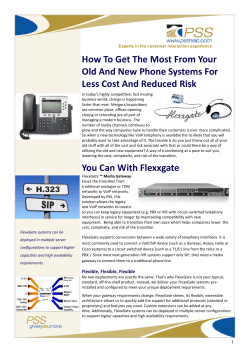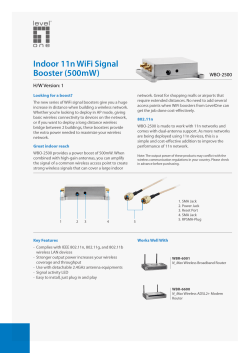
Document 170263
Need Help? Florida Public Service Commission If you are having trouble with your telephone service, contact the customer service number for your service provider and try to resolve the situation. The Florida Public Service Commission (FPSC) can help with all billing complaints, while help with service complaints applies only to basic wireline service. The FPSC does not regulate cellular telephone companies. The Federal Communications Commission (FCC) does not regulate contractual arrangements with cellular providers, but does handle complaints about wireless service. Call the FCC at 1-800-CALL-FCC (1-800-225-5322) or TTY 1-888-835-5322 or fill out a complaint form on its Web site at http://www.fcc.gov. If you have questions, call the Florida Public Service Commision’s Division of Safety, Reliability and Consumer Assistance at 1-800-342-3552, Choosing Telephone Service fax your questions to 1-800-511-0809, or contact the FPSC by e-mail to contact@psc.state.fl.us. Write to the Florida Public Service Commission Division of Safety, Reliability and Consumer Assistance 2450 Shumard Oak Boulevard Tallahassee, Florida 32399-0850 See our Internet home page at www.floridapsc.com How to Choose Choos ose a Residential, Res Reesi siiddeential, ntti l, Wiireelesss Provider Prrovv er Business, and Wireless he im important p nt andd other unications nicatio caa innformation matio telecommunications information HOW TO CHOOSE A HOW TO CHOOSE A Residential Telephone Service Provider Wireless (Cell Phone) Provider As communication technology becomes increasingly complex, choosing a telephone company for your residential service can be a decision-making challenge. The following steps will help you decide which company is best for your needs. Numerous wireless service providers for cell phones compete for your business, and your decision to go with a particular company’s plan should be thoroughly researched. Think . . . how and where will you use your cell phone? 1. Analyze your phone communication needs before looking at local options. How many calls do you make per day and per month? What numbers are you calling (local, local toll, long distance, international)? What time of day are you calling most? What other services do you want (call waiting, caller ID, speed dialing, voicemail)? Do you also need Internet access or cable television services? 2. Research and compare plans for telephone service providers in your area. Look in the beginning pages of the phone book or the yellow pages for company listings and contact information. What is the monthly telephone service charge? What calls are included in the monthly charge? What are the costs for extra services? What are the taxes? What is the billing procedure? Is a deposit or activation fee required? What are the late payment fees and fees for switching providers? What discounts are offered for combining services such as broadband (Internet) connections and cable television? What is your monthly telephone budget? Which provider can you reasonably afford? 3. What is the company’s service and reliability record? What are the maintenance, repair, and outage policies? Are there additional service costs? What is the availability of the customer service line? Is there a local office or representative? A service hotline? What are the disconnection and reconnection policies? 4. Is emergency 9-1-1 service included? Find out the following information: COVERAGE Who serves your geographical area? (The cell phone local call area may differ from the wireline local area.) Does the provider cover the areas you want to call locally, regionally, and nationally? Is international service available? USAGE How will you use the phone? Since service plans vary, purchase the plan according to your projected use. For occasional use or emergencies, a prepaid plan with 30 minutes per month may be adequate. A light user making a couple of calls per day may not need more than 60 minutes of time per month. Medium users (15 minutes per day) should plan for about 300 minutes per month, while a heavy user may triple that phone time. The phone dependent business user or traveler may need 1,000 minutes or more per month. Factor in what special features you may need when comparing the different plans. CONTRACTS Consider the overall costs for an extended one- or two-year contract. Ask about monthly fees, other fees, and taxes. How long will a discount or special deal last? What maintenance or service policy is included? Are package deals available for purchasing several services from the company? Read the fine print. You may be responsible for a large early termination fee if you change providers (for whatever reason) before the contract time has expired. TECHNOLOGY Will you be required to purchase the carrier’s phone brand? A “branded” cell phone may limit your ability to transfer files to or from the Internet or other computers. Will you be able to use the same phone if you change service providers? CHOOSING TELEPHONE SERVICE KSU PBX SPECIAL SERVICES CTI When comparing telephone service plans for your business, pplan ahead for possible expansion in two or three years. You could save money by including expansion possibilities rather than later revamping the telephone system. Consider the number of phones, Internet service, fax machines, credit card terminals, and special accessory services needed. B Business telephone systems vary according to the technology used for routing calls. A system’s cabinet is a box where in internal and external routing occur and may also be known as a central office or key system unit (KSU). For video conferenciing and other computer/telephone applications, computer telephony integration (CTI) options will be necessary. Small bbusinesses inesses with fewer than ten employees should consider a KSU-less system (no cabinet necessary) in which the routing software is contained in each telephone. You will probably have to install and program the system yourself, with a cost of about $100-$250 per phone. Businesses with 10-40 employees may find good value and many features in a KSU or key system, which will cost about $300-$1,000 for each employee. Businesses with more than 40 employees should consider a private branch exchange or PBX system that offers more customization and flexibility for upgrades. The initial cost for a PBX system is more costly but has a lower per employee price due to the larger number of lines installed. Compare plans from several service providers to see which option best suits your budget. Before deciding on a provider, ask detailed questions: What is the cost for installation and who will install the system? Who will service any phone problems (the vendor or the provider)? invol Does the vendor or provider give updates for any hardware or softwaree involved in the system? m? Can you provide references of other businesses using your system? Is training available for employees? LINK-UP & LIFELINE Programs The Link-Up and Lifeline programs offer discounts on telephone service for low income individuals and are available with some wireline and some wireless providers. Read more about the qualifications for these programs on the FPSC Web site at www.floridapsc.com, call 800-342-3552 for more information, or contact your local social service office to sign up. Relay services for hearing and sight impaired individuals are also available through all wireline service providers, and special phone equipment may be available for home use. Contact 7-1-1 for more information about relay services in your area. “DO NOT CALL” Sign up for the national “do-not-call” registry to stop annoying sales calls. Registration is free. Call 888-382-1222 or TTY (866) 290-4326 from the phone number you would like to register, or register online at www.donotcall.gov. VVoice over Internet Protocol (VoIP) Prepaid Phone Cards Prepaid phone cards, readily available at retail stores, offer a certain number of telephone minutes after you purchase a card. Offering convenience and potetial savings, the prepaid card offers a set price per minute, regardless of the call distance or time of day. Before purchasing a prepaid phone card, check to see how much each minute of telephone time costs and if international calls will cost more. Read the fine print to see if minutes will be used for ring time or if additional fees are charged to make calls from a pay phone or wireless phone. If an expiration date is listed, the minutes must be used before that time. Some phone cards are rechargeable, allowing you to purchase and add minutes. Voice over Internet Protocol (VoIP) is a telecommunications technology that allows the user to make phone calls using a high speed Internet connection (DSL or cable modem), but bu will not work with dial-up Internet service, satellite, or wireless broadband. With a VoIP system, analog voice w signals signnals are converted to digital data and transported digitally to the at which time the signals may be converted back to an thhe receiver, recei analog signal, depending on the receiver’s phone system. i The largest to VoIP is the lower price compared to traditional wireline services. At this time, gest advantage advantage t VoIP providers viders do d not have to pay many of the taxes associated with regular telephone service. Also, as long as youu have h the VoIP modem and phone adaptor, the service can move with you anywhere. Just be sure to contact your provider before you move. Since broadband service is powered by electricity, you may lose VoIP service during power outages. If you have a home or business security system, make sure the system is compatible with a VoIP setup; ask how the security system will work in case of an outage. Although emergency 911 services must be supplied to all VoIP customers, finding the caller’s physical location has not always been consistent. Ask about the VoIP provider’s E-911 capabilities. How Calls ARE Charged Telephone service providers vary in their methods of billing for calls, so be sure the pricing matches your calling needs. With a flat monthly rate, find out how many local calls can be made for that rate. How will calls be charged after the maximum is reached? Ask if rates will be lower with a calling plan that includes local, local toll, and long distance calls. With a measured rate, calls are billed in increments of time. For example, with 1-minute billing increments, a call that lasts 62 seconds could be billed as a 2-minute call. Look for a plan with the smallest billing increment possible, perhaps as low as 6 seconds. Number Portability To switch service providers, sign up with the new company first. Then contact your old company to remove any carrier freezes you have on your service and to close your account. Let them know you are switching providers. If your long-distance provider stays the same, contact the longdistance company to let them know you have switched local companies so that your current plan follows along. If you change service providers, you can keep your phone number whether the change is from wireline to wireless, wireless to wireline, or wireless to wireless.
© Copyright 2025





















